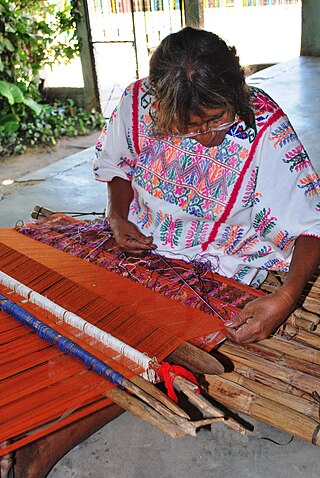Related Research Articles

Amuzgo textiles are those created by the Amuzgo indigenous people who live in the Mexican states of Guerrero and Oaxaca. The history of this craft extends to the pre-Columbian period, which much preserved, as many Amuzgos, especially in Xochistlahuaca, still wear traditional clothing. However, the introduction of cheap commercial cloth has put the craft in danger as hand woven cloth with elaborate designs cannot compete as material for regular clothing. Since the 20th century, the Amuzgo weavers have mostly made cloth for family use, but they have also been developing specialty markets, such as to collectors and tourists for their product.

Florentina López de Jesús was a traditional Amuzgo weaver from Xochistlahuaca, Guerrero, Mexico. Her work was recognized by various awards.

The handcrafts of Guerrero include a number of products which are mostly made by the indigenous communities of the Mexican state of Guerrero. Some, like pottery and basketry, have existed relatively intact since the pre Hispanic period, while others have gone through significant changes in technique and design since the colonial period. Today, much of the production is for sale in the state's major tourism centers, Acapulco, Zihuatanejo and Taxco, which has influence the crafts’ modern evolution. The most important craft traditions include amate bark painting, the lacquerware of Olinalá and nearby communities and the silverwork of Taxdo.

Ángel Santos Juárez is a Mexican potter known for his miniatures and decorative work, which has won various awards.
Leonarda Estrella Laureano is a Mayo Mexican potter from Capomos, El Fuerte in Sinaloa.
Cesar Torres Ramírez is a Mexican potter who specialized in the country Talavera pottery tradition. His work has been featured in books such as Cerámica Y Cultura: The Story of Spanish and Mexican Mayólica of the Museum of International Folk Art in New Mexico, in the Grandes Maestros de Arte Popular Mexicano as a “grand master” by the Fomento Cultural Banamex and as one of Mexico's best artisans in a documentary on Canal Once in Mexico.
Celso Camacho Quiroz is a fourth-generation Mexican potter who works in Metepec, in the State of Mexico. His specialty is the making of large cooking vessels called “cazuelas,” traditionally used to cook mole and rice, but he also makes a number of other utilitarian and decorative pieces. His work has been recognized with awards such as the Gran Premio de Arte Popular from FONART in 1999 and being named a “grand master” by the Fomento Cultural Banamex in 2003.
Miguel Chan and Roger Juárez are Mexican potters, partners in producing Mayan culture-inspired pottery in Ticul, in the state of Yucatán. Ticul, along with Mama and Maxcanú are traditional pottery centers for the state, where pieces are made using a k´abal, a rudimentary form of pottery wheel. The pieces are decorated using implements that they make themselves from branches, leather, gourds and feathers.

Apolinar Hernandez Balcazar is a Mexican basket maker from San Martin Coapaxton, Tenancingo, State of Mexico, whose work has won various national awards.
The Villajuana family are Mexican artisans specializing in hammocks from Euan, Tixkokob, Yucatán in southern Mexico. Their work has been recognized by being named “grand masters” by the Fomento Cultural Banamex.
Andrés Uc Dzul (1910–2004) was a Mexican artisan specializing in the creation of palm hats, especially Panama hats. His work was in great demand in the first half of the 20th century, and he was later recognized as a “grand master”.
Rosalinda Cauich Ramirez is a Mexican artisan specializing in basket weaving. Her work has been recognized with various awards.

Fortunato Moreno Reinoso is a Mexican artisan from Ixmiquilpan, Hidalgo in central Mexico. He is noted for his work in reeds and bamboo, a tradition from the Otomi group to which he belongs, learning it from his father and grandfathers.
The Pineda Palacios is a Mexican family of artisans which specializes in the making of nativity scenes with figures made from palm fronds. Their work has been recognized by being named “grand masters” of Mexican handcrafts by the Fomento Cultural Banamex.
María Quiñones Carrillo is a Mexican basket maker, who has been named a “grand master” of Mexican handcrafts by the Fomento Cultural Banamex.

Mario Agustín Gaspar is a Mexican artisan known for his work in “maque” a pre Hispanic lacquer and “pasta de caña” sculptures made from a corn-stalk paste. He works in the lakeside town of Pátzcuaro, Michoacán, along with his wife, Beatriz Ortega Ruiz, also an artisan in her own right. Gaspar's work can be found in collections both in Mexico and abroad, including the Vatican and he has won various awards for his life's work.
Pablo Dolores Regino is a Mexican lacquer artisan from Temalacatzingo, Guerrero.

Basketry of Mexico has its origins far into the pre Hispanic period, pre-dating ceramics and the domestication of crops. By the time the Spanish arrived, there were a number of indigenous forms, a number of which are still made today. These and products that the Spanish introduced form the combined tradition that remains today. Like other Mexican handcrafts, sales to tourists and collectors is important, but basketry is not as popular as other handcrafts. Basketry techniques and materials vary from region to region depending on the vegetation available, with important traditions in Sonora, State of Mexico, Michoacán, Veracruz, Oaxaca and the Yucatán Peninsula.

Hidalgo (state) handcrafts and folk art are mostly made for local consumption rather than for collectors, although there have been efforts to promote this work to a wider market. Most are utilitarian and generally simply decorated, if decorated at all. The most important handcraft traditions are pottery, especially in the municipality of Huejutla and textiles, which can be found in diverse parts of the state. Most artisans are indigenous, with the Otomi populations of the Mezquital Valley being the most dominant. Other important handcrafts include basketry, metal and wood working.